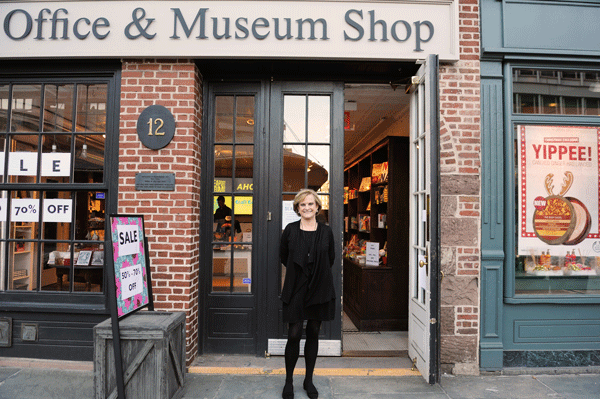
BY TERESE LOEB KREUZER | On Oct. 6, it will have been exactly one year since the Museum of the City of New York formally took over the management of the moribund South Street Seaport Museum with the intention of resurrecting it.
The 40-year-old museum at 12 Fulton St. had laid off most of its staff, mothballed its historic ships and all but closed completely when M.C.N.Y. director Susan Henshaw Jones and her staff swooped in. They immediately reopened Bowne and Company Stationers, the museum’s historic print shop, hired two archivists to reorganize the museum’s library and appointed a waterfront director to assess the condition of the ships and get them going again where possible.
Within months of the acquisition, M.C.N.Y. inaugurated ambitious programming for children and organized an exhibit that opened in late January.
M.C.N.Y.’s contract with the city Economic Development Corporation for the management of the South Street Seaport Museum was to last for one year and an additional, optional six months.
“We have definitely extended, formally and officially,” said Jones.
She said that, in many respects, things are going very well. By the end of the year, an anticipated 100,000 people will have visited the maritime museum. “We’re at 68,000 so far,” said Jones, “having opened on Jan. 25.”
The Ambrose lightship, the first ship in the maritime museum’s collection, is also a success story. It was taken to Staten Island for hull repairs and repainting last fall and was returned to its usual spot on Pier 16 in early March. The museum has the $400,000 needed to finish the job, which includes deck repairs. Half of the money came from Manhattan Borough President Scott Stringer’s office, and the other half was from City Council Member Margaret Chin.
For the price of an admissions ticket, visitors can board the Ambrose and also take in the museum’s land-based exhibits.
The museum’s other ships have been a costly challenge. Jones estimates that it will take $20 million to repair the Wavertree, which is on the National Register of Historic Places and was one of the world’s last large sailing ships to be built of wrought iron. Having just received grants of $1.3 million each from the mayor’s office and from the City Council — on top of money that was previously allocated — the museum now has $5.1 million toward the cost of restoration. The funds will be used for hull repair, which will entail taking the ship into dry dock.
The first step will be to engage a marine surveyor to figure out exactly where the repairs are needed. Then, said Jones, “We have to write a scope of work and let the bids out. Then we have to let the contract. There are many months of work involved.”
In fact, the process will take more than the six months that remain on the M.C.N.Y.’s contract to manage the South Street Seaport Museum. But, Jones added, “We can’t not do things that have a longer time frame, because if we did we would just be putting everything into further jeopardy.”
Jones said that the balance of the money required to repair the Wavertree will come from a combination of government subsidies and private sources such as foundations, corporations and individuals. “It’s a big and hard process,” she said.
The Peking — a four-masted barque once used to carry nitrate around Cape Horn at the tip of South America — is also proving to be a challenge. Because of the way that the E.D.C. developed Pier 15, taking away some of the space formerly used by the South Street Seaport Museum, the museum no longer has room for the Peking. In addition, the ship needs extensive repairs.
Jones has been trying to repatriate the ship to Hamburg, Germany, where it was built, and had hoped it would be gone by May. Museum volunteers spent August and early September emptying the Peking to prepare it for departure. “We took off over 50 tons of debris and equipment,” Jones said.
Much to the E.D.C.’s dissatisfaction, the Wavertree remains on Pier 15, but it can’t be moved until the Peking departs.
Another of the museum’s vessels, the Lettie G. Howard, is at the Mystic Seaport in Connecticut, where it is undergoing evaluation. It was found that rot in the schooner’s keelson — the centerline of the ship to which the frame and floors are attached — was worse than anticipated. “Our Seaport volunteers will do the maintenance she needs before we replace her keelson,” said Jones. “If she’s here, people will see her. We can throw parties for her. We can publicize her plight. She is a beautiful boat, and so we’ll bring her back down.”
The management of the land-based part of the museum presents fewer obstacles.
An exhibit by watercolorist Frederick Brosen called “Romancing New York” is opening this month and is running through Jan. 6, 2013. Another exhibit — a juried show of New York street photography by amateur and professional photographers — will open later this fall.
Though M.C.N.Y.’s management contract for the South Street Seaport Museum extends to next April, Jones said that a decision will have to be made by February as to whether the relationship can continue.
“The trustees of the Museum of the City of New York are the ones who are going to make the final decision,” she said. “I think that they are impressed with what we’ve accomplished, but they are mindful of the uncertainties in the future.”


































